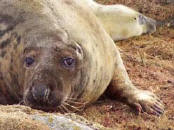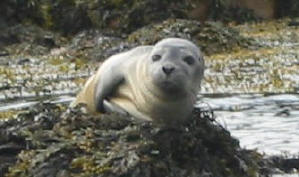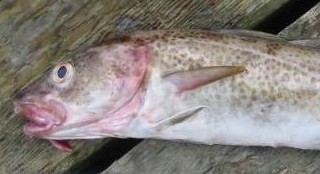| Home | About | Contact |
|
|
The Plankton Paradox | |||
|
As cod and other fish have virtually disappeared from Nova Scotian waters, scientists have recorded a broad, sustained shifting pattern in the oceanic plankton. And the particulars of the plankton changes are quite puzzling. Plankton refers to the swarm of tiny living things in seawater: plants, animals, and eggs and larvae of larger sea animals, and plankton can be considered to be the “essence” of marine animal life. However, marine science is so young that various “chicken and egg” aspects of today’s shifting ocean picture remain largely unexplored – meaning that it has not yet been clearly demonstrated either that plankton controls fish or that fish control plankton.
“C. finmarchicus” is a small plankton-dwelling crustacean (one of the “zooplankton”) that represents the major plankton food link that contributes to the nutrition of fish. Also known as “Calanus,” C. finmarchicus progresses through six distinct life stages (hence the (I-IV) and (V-VI) designations), and it is larger and more nutritious than “Para/Pseudo-calanus.” The dramatic decline in Calanus (by roughly half) therefore represents a “watering down” of fish food between 1962-1973 and 1991-2001. DFO has reported that krill counts have similarly fallen to low levels in recent years. Krill are shrimp-like larger forms of plankton that are commonly eaten by fish, whales and seabirds. The puzzle is “why”…why have Calanus and krill declined while the phytoplankton counts have risen? One “chicken and egg” possibility that should be considered is that removing the bulk of the fish might have unexpectedly induced a weakening of the zooplankton. This would be bad, indeed it would be quite a shock to human investigators. Regardless, the reality seems to be that the production of fish food, Calanus and krill, is declining. This does not bode well for fish, or ultimately for fish-consumers, such as seals and others. Below, a graphic representation of the changes observed over four decades on the Eastern Scotian Shelf (reproduced from Frank et al, 2003) How have the plankton changes been interpreted by scientists? Interestingly, rather than concluding that fewer Calanus reflects a slowing of their rate of production, the hypothesis offered by DFO (2003) is that the presence of fewer Calanus reflects an increase in the numbers of predators feeding on them. Which predators? Not cod – obviously – but herring, are thought to have greatly increased their numbers in Nova Scotian waters in recent years, reaching a point where they are now “grazing” down Calanus and krill to unusually low levels. But why might herring have increased? This is thought to be a consequence of the loss of their major predators, which were bigger fish such as cod. But then, why have cod not rebounded and subdued this overgrowth of herring? This is where the SEALS come in…it is suspected that seal predation is now preventing the recovery of cod numbers by holding them down in a “predator pit.” A neat hypothetical scenario, perhaps, with the seal now acting as the kingpin who is forcing the entire observed distortion of the ocean ecosystem. Seals keep cod down, which allows herring to rise, which causes zooplankton to be held down, which allows phytoplankton to rise. Dominos falling neatly in alternate directions…? Is this plausible? DFO’s hypothesis, that a simple “top-down trophic cascade” has occurred, is strongly contradicted by the starved condition of cod once they grow large enough to begin to eat smaller fish such as herring. (MacKenzie, 2002) An examination of DFO’s assessment techniques has revealed the likelihood of a huge error in their estimation of herring numbers. (MacKenzie, 2003) If herring are NOT currently at an unusually high abundance (despite DFO's recent estimate of a 500-fold rise)…but are instead only at or below historic levels, then seals can no longer even hypothetically be held accountable for the observed “cod down/herring up/zooplankton down” shift. AND…the declining zooplankton becomes the single variable that most urgently needs to be explained by marine science. Therefore, a lot hinges on herring…including, unexpectedly, arguments that blame seals for the lack of rebuilding by the Canadian cod stocks. However, DFO has refused to be challenged on their herring assessment. This is a bad show. Do we really have zero accountability in Canadian publicly funded marine science? But worse, a lot more hinges on zooplankton:…herring …right whale …roseate tern …mackerel …basking shark …humpback whale …puffin …haddock …capelin …grey seal …osprey …tuna …porpoise …smelt …salmon …cormorant …gaspareau …gannet …cod ……humans?
References DFO, 2003. State of the Eastern Scotian Shelf Ecosystem. DFO Ecosystem Status Report 2003/004. Frank, Kenneth, Jae Choi, Scott Coffen-Smout, Ken Drinkwater, Brian Petrie, Glen Harrison, Heather Breeze, Alida Bundy and Phil Yeats, 2003. State of the Ecosystem Report for the Eastern Scotian Shelf. Atlantic Zone Monitoring Program Bulletin No. 3, December, 2003. MacKenzie, Debbie, 2002. The Downturn of the Atlantic Cod (Gadus morhua) in Eastern Canada: what is happening to these fish and why? http://www.fisherycrisis.com/nscod.htm MacKenzie, Debbie, 2003. “Extraordinary” increase in herring, mackerel, and capelin numbers on the Eastern Scotian Shelf?! http://www.fisherycrisis.com/DFO/baitfish.htm
| ||||


